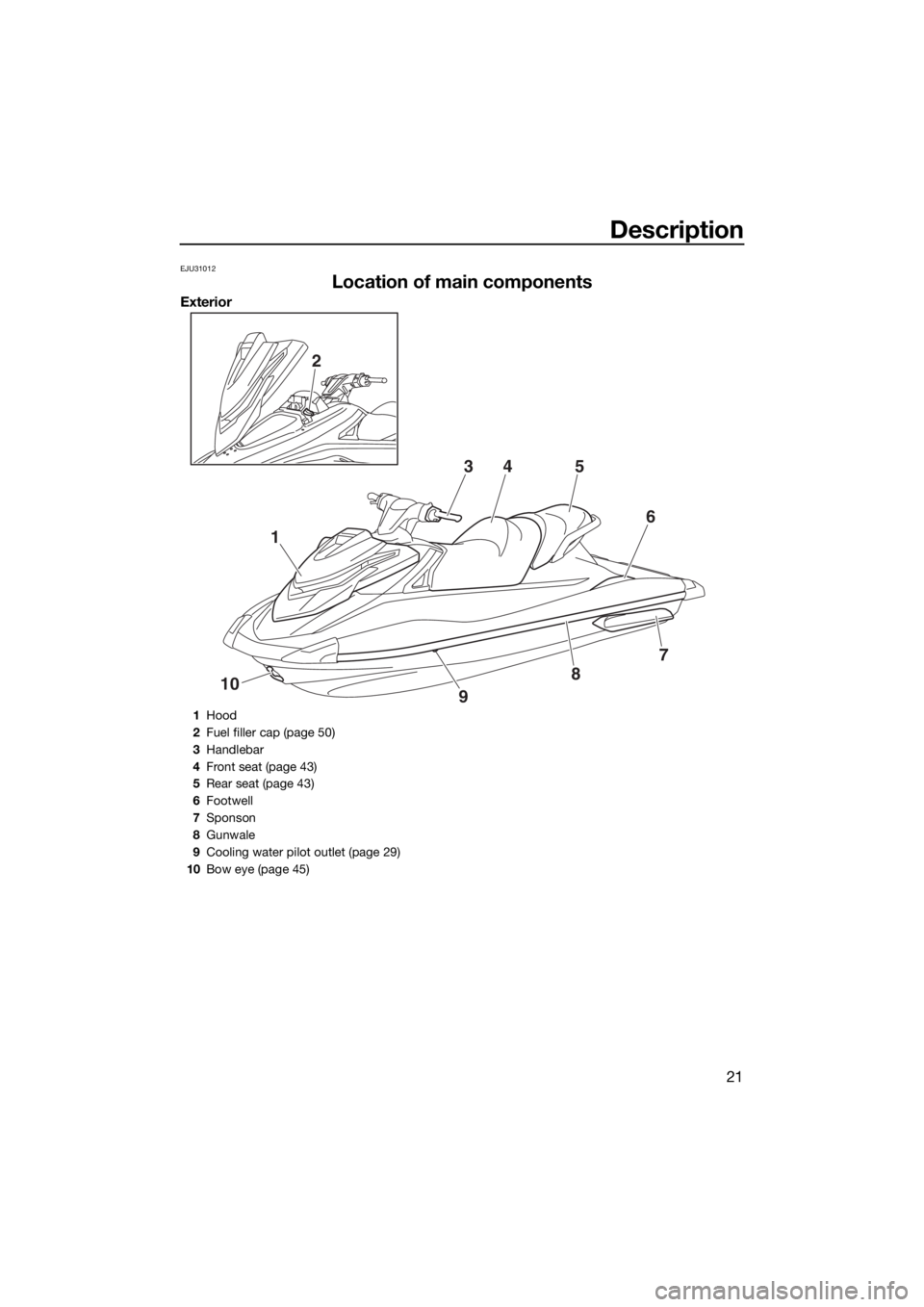fuel cap YAMAHA VXR 2015 Owners Manual
[x] Cancel search | Manufacturer: YAMAHA, Model Year: 2015, Model line: VXR, Model: YAMAHA VXR 2015Pages: 108, PDF Size: 3.59 MB
Page 27 of 108

Description
21
EJU31012
Location of main components
Exterior
1
10
2
345
6
7
8
9
1Hood
2Fuel filler cap (page 50)
3Handlebar
4Front seat (page 43)
5Rear seat (page 43)
6Footwell
7Sponson
8Gunwale
9Cooling water pilot outlet (page 29)
10Bow eye (page 45)
UF2W70E0.book Page 21 Tuesday, December 8, 2015 9:03 AM
Page 30 of 108

Description
24
Engine compartment
1
3
561011789
24
1Electrical box
2Spark plug/Spark plug cap/Ignition coil
3Engine oil filler cap (page 52)
4Removable watertight storage compart-
ment (page 48)
5Air filter case
6Water separator (page 29)
7Fuel tank8Dipstick
9Engine cover
10Battery (page 60)
11Flushing hose connector
UF2W70E0.book Page 24 Tuesday, December 8, 2015 9:03 AM
Page 35 of 108

Control function operation
29
zle is changed, and the direction of the water-
craft is changed accordingly.
Since the strength of the jet thrust determines
the speed and degree of a turn, throttle must
always be applied when attempting a turn,
except at trolling speed.
This model is equipped with the Yamaha En-
gine Management System (YEMS) that in-
cludes an off-throttle steering (OTS) system.
It will activate at planing speeds should you
attempt to steer the watercraft after releasing
the throttle lever. The OTS system assists in
turning by continuing to supply some thrust
while the watercraft is decelerating, but you
can turn more sharply if you apply throttle
while turning the handlebars. The OTS sys-
tem does not function below planing speeds
or when the engine is off. Once the engine
slows down, the watercraft will no longer turn
in response to handlebar input until you apply
throttle again or you reach trolling speed.EJU35975Cooling water pilot outlet
When the engine is running, some of the
cooling water that is circulated in the engine
is discharged from the cooling water pilot
outlet.
There is a cooling water pilot outlet on the
port (left) side of the watercraft. To check for
proper operation of the cooling system, make
sure that water is being discharged from the
cooling water pilot outlet. If water is not being
discharged from the outlet, stop the engine
and check the jet intake for clogging. (See
page 94 for information on the jet intake.)
TIP:
It will take about 60 seconds for the water
to reach the outlet after the engine is start-
ed.
Water discharge may not be constant
when the engine is running at idling speed.
If this occurs, apply a little throttle to make
sure that water discharges properly.
EJU40323Water separator
The water separator prevents water from en-
tering the fuel tank by collecting any water
that has entered the fuel tank breather hose if
the watercraft was capsized.
1Handlebar
2Jet thrust nozzle
1
21Cooling water pilot outlet
1
UF2W70E0.book Page 29 Tuesday, December 8, 2015 9:03 AM
Page 57 of 108

Operation and handling requirements
51
(5) Loosen the fuel filler cap and remove it.
(6) Slowly add fuel to the fuel tank.
(7) Stop filling when the fuel level reaches
approximately 50 mm (2 in) from the top
of the fuel tank. Do not overfill the fuel
tank. Because fuel expands when it
heats up, heat from the engine or the sun
can cause fuel to spill out of the fuel tank.Do not leave the watercraft with a full
tank in direct sunlight.
(8) Wipe up any spilled fuel immediately with
a dry cloth.
(9) Securely install the fuel filler cap by tight-
ening it until it clicks.
(10) Return the hood to its original position,
and then push the hood latch down to
securely lock it in place. Make sure that
the fuel filler cap and the hood are se-
1Fuel filler cap
Fuel tank capacity:
70 L (18.5 US gal, 15.4 Imp.gal)
1
1Top of the fuel tank
2Approximately 50 mm (2 in) from top of the
fuel tank
1Top of the fuel tank
2Approximately 50 mm (2 in) from top of the
fuel tank
12
21
UF2W70E0.book Page 51 Tuesday, December 8, 2015 9:03 AM
Page 65 of 108

Pre-operation checks
59
EJU32282
Pre-operation check pointsEJU42382Pre-launch checks
Perform the pre-launch checks in the pre-op-
eration checklist while the watercraft is on
land.
To perform the pre-launch checks:
(1) Remove the seats and removable water-
tight storage compartment. (See page 43
for seat removal and installation proce-
dures and page 48 for information on the
removable watertight storage compart-
ment.)
(2) Perform the checks and make sure that
there are no malfunctioning items or oth-
er problems.
(3) After completing these checks, securely
install the removable watertight storage
compartment and seats in their original
positions.
EJU32334Engine compartment check
WARNING
EWJ00462
Failure to ventilate the engine compart-
ment could result in a fire or explosion. Do
not start the engine if there is a fuel leak.
Ventilate the engine compartment. Leave the
engine compartment open for a few minutes
to allow any fuel vapors to escape.Make sure that there is no damage inside the
engine compartment.
EJU34215Fuel system checks
WARNING
EWJ00382
Leaking fuel can result in fire or explosion.
Check for fuel leakage regularly.
If any fuel leakage is found, the fuel sys-
tem must be repaired by a qualified me-
chanic. Improper repairs can make the
watercraft unsafe to operate.
Make sure that there is no damage, leakage,
or other problem in the fuel system.
Check:
Fuel filler cap and seal for damage
Fuel tank for damage and leakage
Fuel hoses and joints for damage and leak-
age
Fuel tank breather hose for damage and
leakage
EJU36875Fuel level check
Check the fuel level in the fuel tank.
Add fuel if necessary. (See page 50 for infor-
mation on filling the fuel tank.)
UF2W70E0.book Page 59 Tuesday, December 8, 2015 9:03 AM
Page 86 of 108

Care and storage
80
EJU37146
Post-operation care
WARNING
EWJ00331
Always place the watercraft upright in a
horizontal position when storing it, other-
wise fuel could leak out into the engine or
engine compartment, which could create
a fire hazard.
After using the watercraft, always take it out
of the water, clean it, and store it. Leaving the
watercraft in the water for extended periods
will accelerate the rate of normal deteriora-
tion of the jet pump and hull. Marine organ-
isms and corrosion are some of the
conditions that can shorten the life of many
watercraft components.
EJU43651Flushing the cooling water passages
NOTICE
ECJ01311
Do not run the engine over 4000 r/min on
land. Also, do not run the engine for more
than 15 seconds without supplying water,
otherwise the engine could overheat.
Flush the cooling water passages to prevent
them from clogging with salt, sand, or dirt.
(1) Place the watercraft in a horizontal posi-
tion.
(2) Remove the seats and watertight stor-
age compartment. (See page 43 for seat
removal and installation procedures and
page 48 for information on the watertight
storage compartment.)(3) Connect the garden hose adapter to a
garden hose.
(4) Loosen the flushing hose connector cap
and remove it. Insert the garden hose
adapter into the flushing hose connector
by pushing and twisting it until it is se-
curely connected.
(5) Connect the garden hose to a water tap.
(6) Make sure that the area around the wa-
tercraft is clear, and then start the en-
gine. Immediately after the engine starts,
fully turn the water supply on so that wa-
1Garden hose adapter
1Garden hose adapter
2Flushing hose connector
3Flushing hose connector cap
3
2
1
UF2W70E0.book Page 80 Tuesday, December 8, 2015 9:03 AM
Page 93 of 108

Maintenance
87
EJU43101Periodic maintenance chart
The periodic maintenance chart gives general guidelines for periodic maintenance. Have a
Yamaha dealer perform the checks in the following chart. However, maintenance may need
to be performed more frequently depending on your operating conditions. If you have any
questions, consult a Yamaha dealer.
This “√” mark indicates items to be checked and serviced by a Yamaha dealer.
Item OperationInitial Thereafter every
Page
10 hours50 hours
or 12
months
*1100
hours or
12
months
*1200
hours or
24
months
*1
Fuel lineCheck fuel hoses and
clamps√—
Fuel filler cap/Wa-
ter separatorCheck O-rings for cracks
and deformation√—
Fuel tankCheck installation and
straps√—
Water inlet strainerCheck for clogs and dam-
age√—
Cooling water hos-
esCheck for damage and
leakage, and check
clamps√—
Engine oilReplace√√89
Oil filterReplace√89
Intermediate hous-
ingLubricate√—
Spark plugsCheck√√—
BatteryCheck specific gravity of
electrolyte, terminals,
bands, and breather hose√—
Battery leadsCheck terminals√—
Steering masterCheck operation and for
looseness√√—
Steering cableCheck exterior and con-
nections, and lubricate√—
Electric trim rodCheck exterior and con-
nections, and lubricate√—
Shift rod and re-
verse gateCheck exterior and con-
nections, and lubricate√—
Air filter elementCheck for damage and
dirt√—
Air intake hosesCheck for damage, and
check clamps√
—
Throttle bodyLubricate throttle valves√—
UF2W70E0.book Page 87 Tuesday, December 8, 2015 9:03 AM
Page 96 of 108

Specifications
90
EJU34543
Specifications
Watercraft capacity:
Maximum people on board:
3 person
Maximum load capacity:
240 kg (530 lb)
Dimensions:
Length:
VXS 3340 mm (131.5 in)
VXR 3350 mm (131.9 in)
Width:
1220 mm (48.0 in)
Height:
1190 mm (46.9 in)
Dry weight:
VXS 347 kg (765 lb)
VXR 348 kg (767 lb)
Performance:
Maximum output (according to ISO 8665/SAE
J1228):
132.4 kW@7600 r/min
Maximum fuel consumption:
48.7 L/h (12.9 US gal/h, 10.7 Imp.gal/h)
Cruising range at full throttle:
1.44 hour
Trolling speed:
1300 ±100 r/min
Engine:
Engine type:
Liquid cooled 4-stroke, DOHC
Number of cylinders:
4
Engine displacement:
1812 cm³
Bore × stroke:
86.0 × 78.0 mm (3.39 × 3.07 in)
Compression ratio:
11.0 : 1
Valve clearance-intake (cold):
0.14–0.23 mm (0.0055–0.0091 in)
Valve clearance-exhaust (cold):
0.28–0.37 mm (0.0110–0.0146 in)
Lubrication system:
Wet sump
Cooling system:
Water
Starting system:
ElectricIgnition system:
T.C.I.
Spark plug:
LFR6A
Spark plug gap:
0.8–0.9 mm (0.031–0.035 in)
Battery capacity:
12 V, 19 Ah
Charging system:
Flywheel magneto
Drive unit:
Propulsion system:
Jet pump
Jet pump type:
Axial flow, single stage
Impeller rotation:
Counterclockwise
Jet thrust nozzle angle:
24.0+24.0 °
Jet thrust nozzle trim angle:
-6, -3, 0, 3, 6 °
Fuel and oil:
Recommended fuel:
Regular unleaded gasoline
Minimum octane rating (PON):
86
Minimum octane rating (RON):
90
Recommended engine oil type SAE:
SAE 10W-30, 10W-40, 20W-40, 20W-50
Recommended engine oil grade API:
API SE,SF,SG,SH,SJ,SL
Fuel tank total capacity:
70 L (18.5 US gal, 15.4 Imp.gal)
Engine oil quantity with oil filter replacement:
3.6 L (3.81 US qt, 3.17 Imp.qt)
Engine oil quantity without oil filter replacement:
3.5 L (3.70 US qt, 3.08 Imp.qt)
Engine oil total quantity:
5.3 L (5.60 US qt, 4.66 Imp.qt)
UF2W70E0.book Page 90 Tuesday, December 8, 2015 9:03 AM
Page 97 of 108

Trouble recovery
91
EJU34562
Troubleshooting
If you have any trouble with your watercraft, use the troubleshooting chart to check for the
possible cause.
If you cannot find the cause, consult a Yamaha dealer.
EJU43512Troubleshooting chart
Confirm the possible cause and remedy, and then refer to the applicable page.
TROUBLE POSSIBLE CAUSE REMEDY PAGE
Engine does not
start (Starter motor
does not turn over)Ya m a h a S e -
curity SystemLock mode selected Select unlock mode
26
Engine shut-
off switchClip not in place Install clip
27
Fuse Burned out Replace fuse and
check wiring96
Battery Run down Recharge 81
Poor terminal con-
nectionsTighten as required
81
Terminal corroded Clean or replace 81
Starter motor Faulty Have serviced by
Yamaha dealer—
Engine does not
start (Starter motor
turns over)Throttle lever Squeezed Release 27
Faulty Have serviced by
Yamaha dealer—
RiDE lever Squeezed Release 27
Faulty Have serviced by
Yamaha dealer—
Fuel Fuel tank empty Refill as soon as pos-
sible50
Stale or contaminat-
edHave serviced by
Yamaha dealer—
Fuel tank Water or dirt present Have serviced by
Yamaha dealer—
Spark plug Fouled or defective Have serviced by
Yamaha dealer—
Spark plug
capNot connected or
looseHave serviced by
Yamaha dealer—
Connected to wrong
cylinderHave serviced by
Yamaha dealer—
Fuel injec-
tion systemFuel pump faulty Have serviced by
Yamaha dealer—
UF2W70E0.book Page 91 Tuesday, December 8, 2015 9:03 AM
Page 98 of 108

Trouble recovery
92
Engine runs irregu-
larly or stallsFuel Fuel tank empty Refill as soon as pos-
sible50
Stale or contaminat-
edHave serviced by
Yamaha dealer—
Fuel tank Water or dirt present Have serviced by
Yamaha dealer—
Spark plug Fouled or defective Have serviced by
Yamaha dealer—
Incorrect heat range Have serviced by
Yamaha dealer—
Gap incorrect Have serviced by
Yamaha dealer—
Spark plug
capNot connected or
looseHave serviced by
Yamaha dealer—
Cracked, torn, or
damagedHave serviced by
Yamaha dealer—
Electrical wir-
ingLoose connection Have serviced by
Yamaha dealer—
Fuel injec-
tion systemFaulty or clogged in-
jectorsHave serviced by
Yamaha dealer—
Warning light or in-
dicator blinks or
comes onFuel level
warningFuel tank empty Refill as soon as pos-
sible50
Oil pressure
warningOil pressure dropped Have serviced by
Yamaha dealer40
Engine over-
heat warningJet intake clogged Clean
94
Check en-
gine warningFaulty sensors Have serviced by
Yamaha dealer41 TROUBLE POSSIBLE CAUSE REMEDY PAGE
UF2W70E0.book Page 92 Tuesday, December 8, 2015 9:03 AM